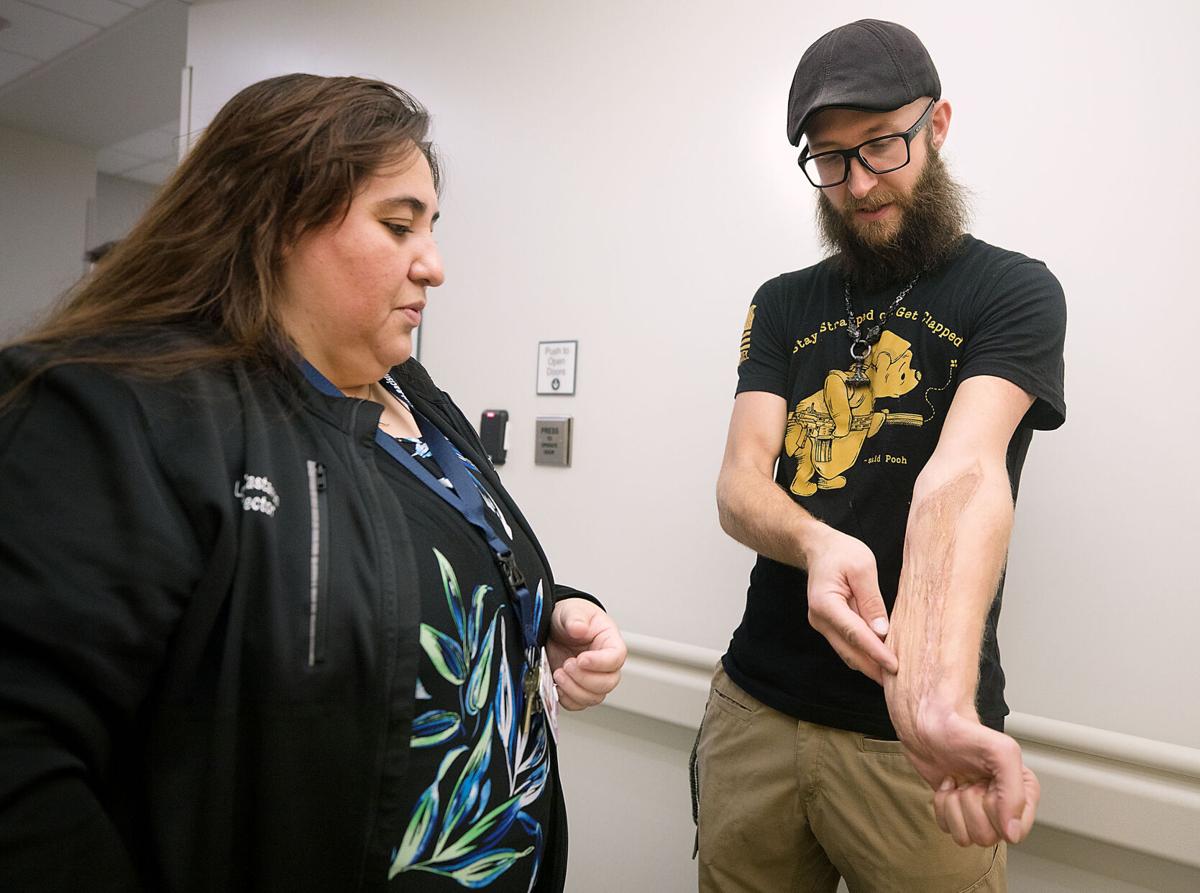Eric Stoltz was finishing work at a local wastewater plant when 13,800 volts of electricity entered a finger on his left hand, traveled up his arm, and then blasted out his left bicep.
Stoltz, who is an electrician, briefly lost consciousness before he woke up, and screamed.
That horrible burn in February 2021 might have required amputation, but after nine surgeries at Banner-University Medical Center Tucson, and extensive therapy following those operations, Stoltz still has — and still can use — his arm and his hand.
What’s also significant to note: Stoltz received the care he needed in Tucson, which hadn’t been an option for many serious burn patients here for over a decade. That’s because Tucson’s previous burn center, at Carondelet St. Mary’s Hospital, closed in 2008. Until recently, people with injuries as serious as his were sent to the burn center at Valleywise Health in Maricopa County.
The shift back to Tucson started about four years ago, when Banner recruited Dr. Lourdes Castañón to help plan, and now direct, Banner’s new burn program. Castañón’s history includes extensive time with both adult burn patients and with children, through Shriners Hospitals for Children.
And so, although the pandemic delayed the start of Banner’s full burn unit opening here until just recently — with an official start and celebration last week — all of Tucson’s burn patients can now get treatment close to home.
Helping patients recover, adjust
The new burn program is part of Banner’s level-one trauma center at 1625 N. Campbell Ave. It offers, all on one hospital floor, help for a variety of injuries, including thermal, chemical and electrical burns, as well as care for serious trauma wounds.
In addition to surgeons and trauma specialists, Castañón said, the new unit also includes specially trained nurses, occupational and physical therapists, pharmacists, registered dieticians, and child life specialists. The center will also focus on research through a “very strong partnership between the University of Arizona and the hospital,” she said.

Eric Stoltz is an electrician who suffered an electrical burn in February 2021 while working on a switch gear. The incident sent 13,800 volts up his left arm and out through his bicep.

Eric Stoltz took photos of his arm during treatment. The incident sent 13,800 volts up his left arm and out through his bicep. He received care at Banner-University Medical Center and returned to work in July 2021.
There are two procedure rooms for burn patients, both equipped with radiant heat panels that can reach up to 95 degrees Fahrenheit to help regulate body temperature, which is critical for burn victims to prevent hypothermia.
The center’s programs are being managed by Tonya Naughton, a registered nurse who has dedicated eight of her 27 work years to burn and trauma treatment. Naughton moved to Arizona from Iowa’s only burn center during the height of the pandemic to work as a nurse quality specialist at Banner-University Medical Center Phoenix. However, she soon found she longed to work in a burn unit again.
“I started looking for open positions and came across a position for a burn program manager to assist (Banner in Tucson) in becoming a verified burn center,” she said, adding that the position was exactly what she wanted to do.
The center is partnering with the Arizona Burn Foundation to connect survivors to support groups, as well as specialized camps, for burn survivors and their families.
Families and loved one of the patients, as well as the patient themselves, often need a variety of supports, said Erika Mendoza, manager of client care services for the foundation.
Sometimes the foundation helps provide lodging for family members, Mendoza said, or helps a patient pay rent as they recover. There is also peer support available from people who have lived through the trauma of being badly burned.
Lingering worry
The voltage that burned Stoltz’s hand and arm jumped from a switchgear, he said, which is similar to a breaker for a house but on a much bigger scale.
When he arrived at the hospital, his wrist and forearm were swelling rapidly, the skin on his wrist was split from the shock, and the skin on his hand had already peeled away.

Dr. Lourdes Castañón, director of the new burn unit at Banner-University Medical Center Tucson, hugs former patient Eric Stoltz.
Stoltz said he didn’t experience a lot pain — except for the dressing changes — because his arm was quite numb. And while he doesn’t have full range of motion with his left thumb, and parts of his hand lack feeling, otherwise things are mostly normal.
Initially, one of the biggest concerns was whether the electricity had harmed his heart.
“I would fall asleep thinking, ‘Am i going to wake up tomorrow?’” he said. After a couple of weeks, he was reassured: His heart was still working well.
“It didn’t cross my chest,” he said of the electricity, “which is why I am still alive today.”

The new burn unit at Banner-University Medical Center Tucson has a tub/procedure room where a patient is brought in for baths and procedures without having to leave the floor. The room can be heated up to keep the patient comfortable.









